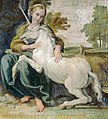Category:Mannerist frescos in Rome
The inclusion of Andrea's Sacchi's "Allegory of Divine Wisdom" as a Mannerist work is hopelessly wrong. Sacchi's fresco is the very opposite of Mannerism, since it represents that classical strain in the Baroque that looked back to Raphael for grace, order and clarity of composition - characteristics entirely opposed to the Mannerists. Furthermore, Mannerism had ended by the time this was painted in the 1630's. This is a work of Baroque Classicism. Sacchi was a pupil of Francesco Albani, another Baroque classicist, who in turn had studied in the Bolognese Academy of the Carracci, where the teaching honoured the High Renaissance masters of the past, above all Raphael, and entirely rejected the complexities and distortions of Mannerism. Domenichino is also wrongly included here. The favourite pupil of Annibale Carracci, he was a Baroque painter of the classicising school and absolutely not a Mannerist. His work was highly regarded by the ultra-classicist Poussin. The only works of the Mannerist period correctly included here are those in the Castel St.Angelo by Perino del Vaga and Pellegrino Tibaldi (although there is little evidence of the Mannerist style since the frescoes imitate ancient Roman grottesche) and those by Francesco Salviati and Taddeo Zuccaro. The latter two (948KB, 595KB and 454KB) especially demonstrate Mannerist qualities: dramatic changes in scale, an exaggerated version of Michelangelo's figure style, and excessively busy composition with little or no tolerance of lucid interval.
Subcategories
This category has the following 21 subcategories, out of 21 total.
Media in category "Mannerist frescos in Rome"
The following 8 files are in this category, out of 8 total.
-
Francesco Salviati 007.jpg 2,024 × 2,742; 431 KB
-
DomenichinounicornPalFarnese.jpg 2,400 × 1,983; 7.11 MB
-
DomenichinounicornPalFarneseFXD.jpg 2,400 × 1,983; 1.64 MB
-
Domenichounicorndetail.jpg 1,446 × 1,599; 3.32 MB
-
San Pietro in Vincoli Affreschi 17042017 1.jpg 3,999 × 2,666; 9.49 MB
-
San Pietro in Vincoli Affreschi 17042017 2.jpg 3,528 × 3,492; 11.17 MB
-
Taddeo Zuccari 001.jpg 3,200 × 2,233; 595 KB
-
Taddeo Zuccari 002.jpg 1,576 × 3,256; 454 KB







